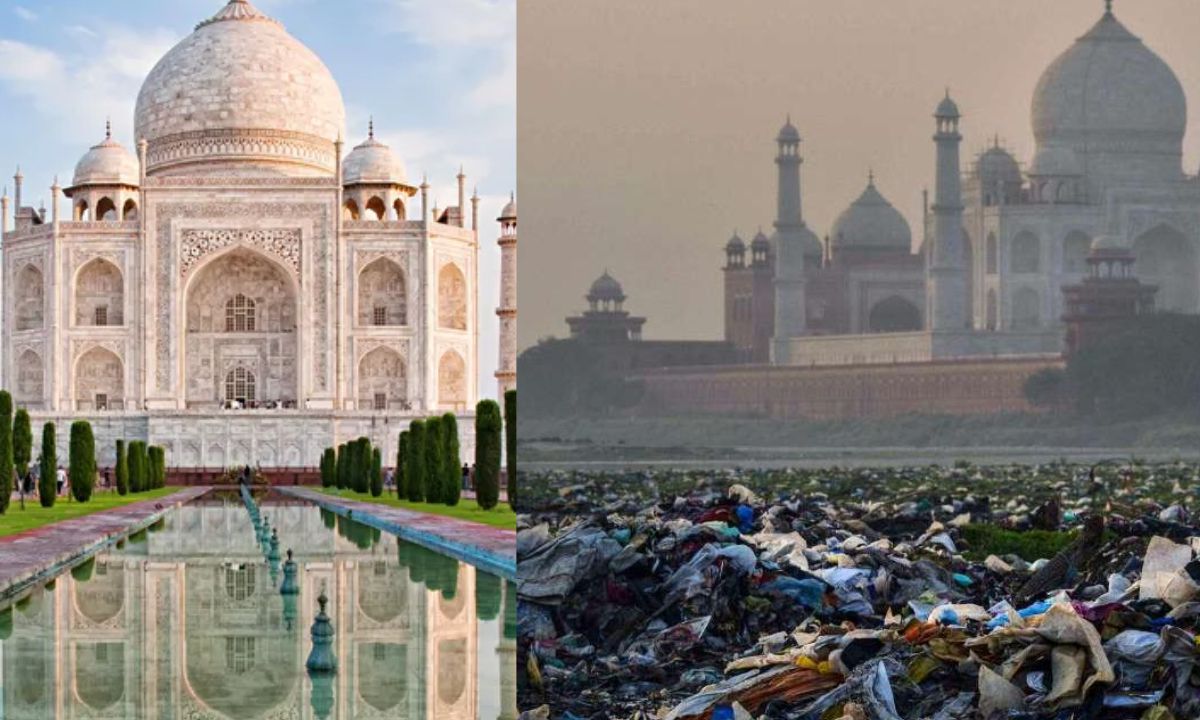The Taj Mahal, often celebrated for its stunning beauty, has suffered dramatically from the effects of air pollution over the years. Once a shimmering white monument, it now bears the marks of environmental degradation, resulting in a yellowish-brown film that obscures its grandeur day and night. This decline is primarily due to pollution from industrial activities and the increasing vehicle emissions in Agra, as well as the pollution of the Yamuna River, which runs behind this UNESCO World Heritage Site.
Causes of Discoloration
The marble of the Taj Mahal has changed color due to several interconnected factors:
- Industrial Emissions: The Taj Trapezium Zone (TTZ), where the monument is located, is plagued by air pollution from nearby industries and heavy vehicular traffic. The high levels of sulfur dioxide and nitrogen oxides contribute significantly to the deterioration of the marble’s surface.
- Yamuna River Pollution: The Yamuna River is heavily polluted, devoid of aquatic life, and filled with sewage and industrial waste. This contamination fosters the growth of insects and algae, which further stain the Taj Mahal. With the river’s ecosystem compromised, natural predators that once controlled insect populations have vanished.
Insect Infestation and Marble Damage
The drying Yamuna has created a breeding ground for insects that harm the Taj Mahal. According to the Archaeological Survey of India, these pests thrive in the polluted debris of the river and often invade the monument in the evenings. The absence of fish and other aquatic life means that these insects proliferate unchecked, leading to increased staining of the marble from their excrement.
Natural Degradation and Pollution
In addition to biological factors, the Taj Mahal is undergoing natural oxidation processes that darken its marble. Coupled with acid rain and soot from nearby homes and industries, the effects of air pollution on the Taj Mahal have compounded over the last few decades. Despite efforts to establish a protective zone around the monument, including the Taj Trapezium Zone, violations of emission regulations persist, exacerbating the monument’s plight.
A Heritage in Crisis
The situation today is dire compared to the conditions of the 1980s when legal actions were first taken to protect the Taj Mahal. Following a Supreme Court ruling in 1984, there was hope for improved preservation, including the designation of Agra as a Heritage City. Unfortunately, over the past 35 years, little progress has been made, and the same issues continue to plague this iconic structure.
Conclusion
The effects of air pollution on the Taj Mahal represent a critical challenge that requires urgent attention. Involving national and international experts can provide comprehensive solutions to safeguard this magnificent monument for future generations. Organizations like 3D Aqua Water Treatment are dedicated to combating various forms of pollution, ensuring that our heritage and environment are preserved.
For inquiries about effective water and wastewater treatment solutions, you can contact us at +91-8963089630 or email info@3daqua.in.
By focusing on the “effects of air pollution on Taj Mahal,” this article aims to raise awareness about the urgent need for action to preserve this iconic symbol of India’s cultural heritage.

